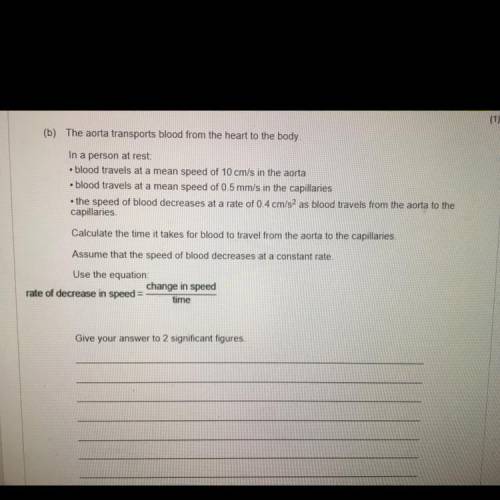The aorta transports blood from the heart to the body.
In a person at rest:
• blood tr...

Biology, 22.12.2021 14:20 serenityburke
The aorta transports blood from the heart to the body.
In a person at rest:
• blood travels at a mean speed of 10 cm/s in the aorta
• blood travels at a mean speed of 0.5 mm/s in the capillaries
• the speed of blood decreases at a rate of 0.4 cm/s2 as blood travels from the aorta to the
capillaries
Calculate the time it takes for blood to travel from the aorta to the capillaries.
Assume that the speed of blood decreases at a constant rate.
Use the equation:
change in speed
rate of decrease in speed = change in speed / time


Answers: 3


Other questions on the subject: Biology


Biology, 22.06.2019 02:30, taythestargazer71
Did you know that a blue wales tongue weighs more than an elephant?
Answers: 2

Biology, 22.06.2019 19:30, jjjxxcsenone1034
How do high-energy electrons from glycolysis and the krebs cycle contribute to the formation of atp from adp in the electron transport chain? a. high-energy electrons interact with pyruvic acid to create a phosphate bond with adp, forming atp. b. high-energy electrons supply the needed energy to synthesize atp from the lower-energy adp in the electron transport chain. c. high-energy electrons supply a negative charge which causes the citric acid to oxidize, forming a phosphate group to bond with adp. d. high-energy electrons increase the temperature of adp so it easily reacts to form atp.
Answers: 2
You know the right answer?
Questions in other subjects:


Mathematics, 28.06.2021 18:20

English, 28.06.2021 18:20



Mathematics, 28.06.2021 18:20

Biology, 28.06.2021 18:20



Health, 28.06.2021 18:20



